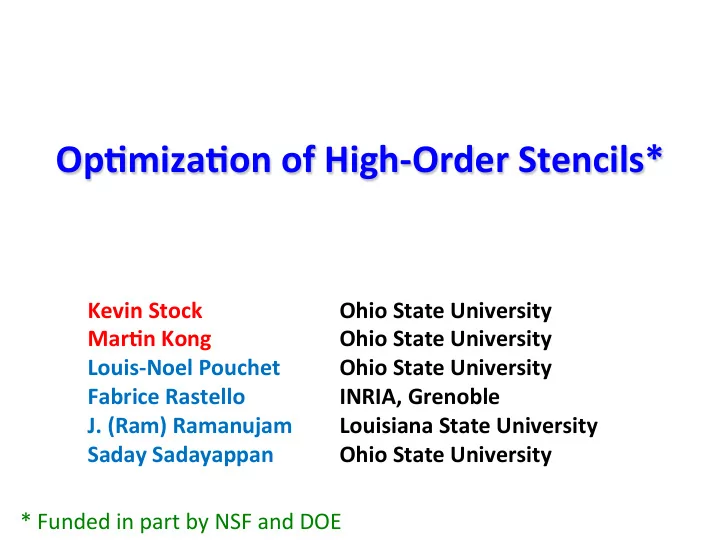

Op#miza#on ¡of ¡High-‑Order ¡Stencils* ¡ ¡ ¡ ¡ Kevin ¡Stock ¡ ¡ ¡ ¡Ohio ¡State ¡University ¡ Mar#n ¡Kong ¡ ¡ ¡ ¡Ohio ¡State ¡University ¡ Louis-‑Noel ¡Pouchet ¡ ¡ ¡Ohio ¡State ¡University ¡ Fabrice ¡Rastello ¡ ¡ ¡ ¡INRIA, ¡Grenoble ¡ J. ¡(Ram) ¡Ramanujam ¡ ¡Louisiana ¡State ¡University ¡ Saday ¡Sadayappan ¡ ¡Ohio ¡State ¡University ¡ * ¡Funded ¡in ¡part ¡by ¡NSF ¡and ¡DOE ¡
int aFunction(int a, int b) { int c=b; 100% ¡ return a; } 80% ¡ main() { int a,b,c,d,e; 60% ¡ int i=4; for (i=0;i<10;i++) { 40% ¡ int j=55; c=i+j; c=aFunction(i,c); a=aFunction(a+1,b); 20% ¡ } #pragma SliceTarget a; 0% ¡ return 0; } 1 ¡ 4 ¡ 8 ¡12 ¡16 ¡ DSL Technology for Exascale Computing (D-TEC) Lead ¡PI ¡ ¡ Deputy ¡PI ¡ Daniel ¡J. ¡Quinlan ¡ Saman ¡Amarasinghe ¡ Lawrence ¡Livermore ¡NaGonal ¡Laboratory ¡ MIT ¡ Co-‑PIs ¡and ¡InsGtuGons ¡ Armando ¡Solar-‑Lezama, ¡Adam ¡Chlipala, ¡Srinivas ¡Devadas, ¡ ¡ Una-‑May ¡O’Reilly, ¡Nir ¡Shavit, ¡Youssef ¡Marzouk ¡@ ¡MassachuseWs ¡InsGtute ¡of ¡Technology ¡ John ¡Mellor-‑Crummey ¡& ¡Vivek ¡Sarkar ¡@ ¡Rice ¡University ¡ Vijay ¡Saraswat ¡& ¡David ¡Grove ¡@ ¡IBM ¡Watson ¡ P. ¡Sadayappan ¡& ¡Atanas ¡Rountev ¡@ ¡Ohio ¡State ¡University ¡ Ras ¡Bodik ¡@ ¡University ¡of ¡California ¡at ¡Berkeley ¡ Craig ¡Rasmussen ¡@ ¡University ¡of ¡Oregon ¡ Phil ¡Colella ¡@ ¡Lawrence ¡Berkeley ¡NaGonal ¡Laboratory ¡ ScoW ¡Baden ¡@ ¡University ¡of ¡California ¡at ¡San ¡Diego ¡
Stencil Example for (i=1; i<N-1; i++) for (j=1;j<N-1; j++) A[i][j] = c*(B[i][j-1] + B[i][j] + B[i][j+1] + B[i-1][j] + B[i+1][j]); • Stencil ¡computaGons ¡sweep ¡ over ¡a ¡regular ¡mulG-‑ dimensional ¡array ¡ • ComputaGon ¡for ¡each ¡element ¡ of ¡result ¡array ¡A ¡uses ¡a ¡fixed ¡ set ¡of ¡neighboring ¡elements ¡ from ¡input ¡array ¡B ¡ • Ample ¡inherent ¡parallelism, ¡ but ¡performance ¡is ¡oben ¡far ¡ below ¡processor’s ¡peak: ¡ without ¡temporal ¡blocking, ¡ limited ¡by ¡memory ¡bandwidth ¡ ¡
Optimizing High-Order Stencils • High-‑order ¡stencils: ¡ weighted ¡averaging ¡over ¡ wider ¡neighborhood ¡ • “Box”wxw ¡stencil ¡=> ¡O(w 2 ) ¡ flops ¡per ¡site ¡(w=2*k+1) ¡ • OperaGonal ¡intensity: ¡O(w 2 ) ¡ ¡ ¡ for (i=k; i<n-k; i++) for (j=k; j<n-k; j++) // ii,jj loops fully unrolled for (ii=-k; ii<=k; ii++) for (jj=-k; jj<=k; jj++) k=1, ¡w=2k+1 ¡= ¡3 ¡ B[i][j] += W[k+ii][k+jj]*A[i+ii][j+jj]; K=2, ¡w=2k+1 ¡= ¡5 ¡
High-Order Stencils: Baseline Performance for (i=k; i<n-k; i++) 10 base 9 for (j=k; j<n-k; j++) 8 7 // ii,jj loops fully unrolled GFLOP/s 6 5 for (ii=-k; ii<=k; ii++) 4 3 for (jj=-k; jj<=k; jj++) 2 1 B[i][j] += W[k+ii][k+jj]*A[i+ii][j+jj]; 0 1 2 3 4 5 6 • MulG-‑core ¡performance ¡ k improves ¡from ¡3x3 ¡to ¡5x5 ¡ base-loads base-stores stencil ¡but ¡drops ¡for ¡higher ¡ 0.7 Memory Ops / FLOP order ¡stencils ¡ 0.6 0.5 • Problem: ¡ ¡ 0.4 – Not ¡memory-‑bw ¡bound ¡ 0.3 0.2 – But ¡too ¡many ¡register ¡ 0.1 loads ¡due ¡to ¡insufficient ¡ 0 1 2 3 4 5 6 registers ¡to ¡get ¡reuse ¡ k ¡
Standard Gather-Gather Stencil w reads from IN 0 reads from OUT 1 write to OUT w 2 − w + 1 registers Six points reused between iterations Sweep ¡Direc#on ¡ (innermost ¡loop) ¡
Reordering Stencil Operations • wxw ¡“box” ¡stencil ¡ computaGon ¡over ¡MxN ¡ domain ¡viewed ¡as ¡a ¡total ¡of ¡ w 2 MN ¡edges ¡ • Standard ¡stencil ¡execuGon ¡ groups ¡all ¡edges ¡incoming ¡ into ¡a ¡site ¡for ¡consecuGve ¡ execuGon ¡ • Regrouping ¡of ¡edges ¡forms ¡a ¡ different ¡“stencil” ¡paWern, ¡ with ¡different ¡#loads/stores ¡ and ¡register ¡pressure ¡ ¡ ¡
Gather-Scatter 1 reads from IN w − 1 reads from OUT w write to OUT w + 1 registers
Scatter-Gather w reads from IN 0 reads from OUT 1 write to OUT w + 1 registers
Performance: Core i7-4770K (4 cores)
Stencils on Vector-SIMD Processors • Fundamental ¡source ¡of ¡ inefficiency ¡with ¡stencil ¡codes ¡ for ¡(i=0; ¡i<H; ¡++i) ¡ ¡ on ¡current ¡short-‑vector ¡SIMD ¡ ¡for ¡(j=0; ¡j<W; ¡++j) ¡ ¡ ISAs ¡(e.g. ¡SSE, ¡AVX ¡…) ¡ ¡ ¡z[i][j]+=y[i][j]+y[i][j+1]; ¡ – Concurrent ¡operaGons ¡on ¡ conGguous ¡elements ¡ – Each ¡data ¡element ¡is ¡reused ¡in ¡ 0 ¡ 1 ¡ 2 ¡ 3 ¡ different ¡“slots” ¡of ¡vector ¡ VR0 ¡ a ¡ b ¡ c ¡ d ¡ register ¡ – Redundant ¡loads ¡or ¡shuffle ¡ops ¡ VR1 ¡ m ¡ n ¡ o ¡ p ¡ needed ¡ VR2 ¡ n ¡ o ¡ p ¡ q ¡ • Data ¡Layout ¡transforma#on ¡ VR3 ¡ based ¡on ¡matching ¡ VR4 ¡ computa#onal ¡characteris#cs ¡of ¡ stencils ¡ ¡to ¡vector-‑SIMD ¡ Vector ¡registers ¡ architecture ¡characteris#cs ¡ ¡ Inefficiency: ¡Each ¡element ¡of ¡ b ¡is ¡loaded ¡twice ¡ a ¡ b ¡ c ¡ d ¡ e ¡ f ¡ g ¡ h ¡ i ¡ j ¡ k ¡ l ¡ z[i][j] ¡ ¡ m ¡ n ¡ o ¡ p ¡ q ¡ r ¡ s ¡ t ¡ u ¡ v ¡ w ¡ x ¡ y[i][j] ¡ ¡ Data ¡in ¡memory ¡
Data Layout Transformation y[0:23] ¡ for (j = 1; j < W-1; ++j) z[j] = y[j-1] + y[j] + y[j+1]; yt[0:23] ¡ (a) 1D ¡vector ¡in ¡memory ¡ ó ¡(b) ¡2D ¡logical ¡view ¡of ¡same ¡data ¡ (c) ¡Transposed ¡2D ¡array ¡moves ¡interacGng ¡elements ¡into ¡same ¡slot ¡of ¡ different ¡vectors ¡ ¡ ó ¡ ¡(d) ¡New ¡1D ¡layout ¡aber ¡transformaGon ¡ • Boundaries need special handling (details in CC 2011 paper)
Performance: Stencil Rate
Summary • High-‑order ¡stencils ¡have ¡high ¡operaGonal ¡ intensity: ¡not ¡limited ¡by ¡memory ¡bw, ¡but ¡face ¡a ¡ different ¡challenge: ¡excessive ¡register ¡loads ¡ • SoluGon ¡via ¡associaGve ¡reordering ¡of ¡ accumulaGon ¡operaGons ¡to ¡change ¡“stencil” ¡ paWern ¡ • Details ¡in ¡PLDI’14 ¡paper ¡ • Ongoing/Future ¡Work ¡ – IncorporaGon ¡into ¡DSL ¡for ¡AMRShib ¡Calculus ¡(Collela) ¡
Recommend
More recommend